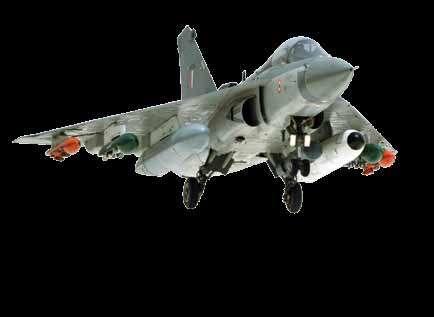
4 minute read
Last Word
IndIgenous CapabIlIty Is the Key
By air marshal b.K. PaNDEY (rEtD)
In the midst of the military confrontation with China,
the Ministry of Defence (MoD) approved a proposal by the Indian Air Force (IAF) to acquire 33 new combat aircraft to boost its rapidly dwindling strength of the combat fleet. Being the first acquisition after the deal for 36 Rafale jets from Dassault, the proposal in question includes the acquisition of 12 Su-30 MKI and of 21 MiG-29UPG multi-role fighter aircraft and upgrade of 59 MiG-29s in service with the IAF to UPG standard at a total cost of around `7,418 crore. The Su-30 MKIs will be manufactured under licence by Hindustan Aeronautics Limited (HAL) once delivery of the 272 aircraft on order is completed. It is understood that the 21 MiG-29UPG aircraft on offer by Russia have already been manufactured against an order by another country which has been cancelled. The fleet of 21 MiG-29UPG aircraft is thus expected to be available soon and at an attractive price.
One clear advantage for the IAF in acquiring the Su-30 MKI and the MiG-29UPG aircraft is that the service has been operating these two platforms for several years and hence induction of both these platforms will be easy especially as the required infrastructure is already available and pilots, technicians as well as other ground crew are already familiar with the two aircraft types. The timing of this acquisition, though somewhat miniscule, when viewed in the context of the huge deficiency in the strength of the combat fleet of the IAF, is seen by some analysts as “a signal to China of the serious intent of the nation”. How strong and meaningful this signal will be, is indeed debatable.
As per an assessment over five decades ago, the IAF would need around 65 combat squadrons as against the authorised strength of 39.5 squadrons at that time, to be able to fight wars successfully against both China and Pakistan in a two-front war scenario. However, the assessed requirement of enhancing the strength of combat squadrons was toned down and the Government restricted the authorised level to 42 squadrons, an enhancement in the strength by just two and a half squadrons from the existing 39.5. Unfortunately, the IAF has been totally dependent on foreign sources for procurement of combat aircraft as despite the massive investment by the Government, the indigenous aerospace industry dominated by the public sector, has not been able to meet with the requirement of the IAF in this regard. During the era of the bi-polar world, the IAF was practically tied down to the Union of Soviet Socialist Republics (USSR) for procurement of military hardware. The IAF was comfortable having procured the MiG-21 and its variants in large numbers, the MiG-23, MiG-25, MiG-27, MiG-29 and the Sukhoi Su-7. While there may have been reservations in some quarters about the quality and capability of these platforms acquired from the USSR, as for numbers, the IAF had no problem as it could maintain the size of the fleet of combat aircraft at the level authorised by the Government. Acquisitions from Western sources were limited and included Hunters, Gants, Ouragan, Mysteres, Jaguars and Mirage 2000. Of these only the last two are still in service.
In February 2009, the UPA Government led by the Congress Party authorised the enhancement of the strength of the combat fleet from the existing 39.5 squadrons to 42 squadron to be achieved by the year 2022. The question of enhancement of the strength of the combat fleet apart, the number of fighter squadrons has in fact reduced drastically and today, it stands at 30 squadrons as against the authorised figure of 42, down by nearly 30 per cent. This is largely on account of obsolescence of the fleets of MiG-21, MiG-23, MiG-25, MiG-27 and Su-7. Platforms of Russian origin that remain in service with the IAF are six squadrons of MiG-21 Bison, an upgraded version of the MiG21, to be retired from service in a few years, three squadrons of MiG-29 inducted from the mid 1980s and the Su-30 MKI whose induction is still continuing.
Efforts by the IAF over the last two decades to restore the strength of its combat fleet at the authorised level, has not been successful. All that has been achieved is two squadrons of the Rafale and the recent acquisition of 21 MiG-29 and 12 Su-30 MKI aircraft, equivalent to two squadrons. In the next few years, the IAF will have to retire the MiG-21 Bison and Jaguars, totalling to 11 squadrons pushing the strength of the combat fleet to 23 squadrons. Not a very healthy state at all.
The role air power in the context of national security is unquestionable. Unfortunately, in this vital segment, what is conspicuous by its absence is contribution by the Indian aerospace industry. Since the delivery of the first light combat aircraft Tejas in 2015, in five years, HAL has produced just enough to equip one squadron. Unless and until the Indian aerospace industry gears up and replaces foreign suppliers of combat aircraft, the IAF will find it extremely difficult to sustain its operational capability. SP










